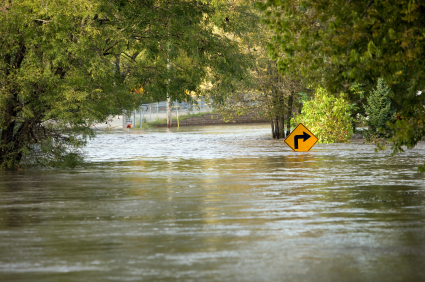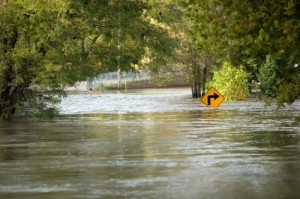 [1]In the Spring, many parts of the country experience their rainy season, and with that comes the possibility of flash floods. This type of emergency is one of the most common hazards in the United States that can be felt locally or have a larger impact on cities and even states. The damage done by floods does not only encompass damaged homes and property but can displace families permanently – even in the safety of your home.
[1]In the Spring, many parts of the country experience their rainy season, and with that comes the possibility of flash floods. This type of emergency is one of the most common hazards in the United States that can be felt locally or have a larger impact on cities and even states. The damage done by floods does not only encompass damaged homes and property but can displace families permanently – even in the safety of your home.
Educating yourself on knowing the warning signs of flooding and what to do in times of floods can help you better prepare your family and your home when a flood is imminent.
All Floods Are Not Created Equal
Those that live in low lying areas or floodplains are more susceptible to flooding. Different types of flooding can affect these floodplains. There are floods that can develop slowly, giving people time to prepare, and evacuate, if necessary; and there are floods that can develop quickly, sometimes in just a few minutes and without any visible signs of rain.
- River Flooding – Flooding along rivers can occur seasonally from melting snow, high rainfall, decaying hurricanes or intense rainstorms that swell river beds.
- Coastal Flooding – Tropical storms, hurricanes, and tsunamis can drive water inland thus creating flooding. This type of flooding can block escape routes thus making it impossible to flee.
- Urban Flooding – As land is converted from fields and woodlands, it loses its ability to absorb large amounts of rainfall. According to the United States Search and Rescue, urbanization increases runoff by 2 to 6 times what would occur on normal terrain. During this type of flooding, streets can fill up with water causing river-like conditions.
- Flash floods – Flash flooding often has a dangerous wall of roaring water that carries rocks, mud, and other debris and can sweep away most things in its path. This type of flooding can occur due to intense rainstorms lasting longer periods of time or can occur due to a breach in a levee or overflow of a river. Typically, flash flooding occurs around streams, rivers, canals, storm drains, flood control channels, canyon and caves.
Source [2]
Be aware of flood hazards no matter where you live, but especially if you live in a low-lying area, near water or downstream from a dam. Even very small streams, gullies, creeks, culverts, dry stream beds, or low-lying ground that appear harmless in dry weather can flood. Every state is at risk from this hazard.
Familiarize yourself with these terms to help identify a flood hazard:
- Flood Watch- Flooding is possible. Tune in to NOAA Weather Radio, commercial radio, or television for information.
- Flash Flood Watch- Flash flooding is possible. Be prepared to move to higher ground; listen to NOAA Weather Radio, commercial radio, or television for information.
- Flood Warning- Flooding is occurring or will occur soon; if advised to evacuate, do so immediately.
- Flash Flood Warning- A flash flood is occurring; seek higher ground on foot immediately.
How to Prepare for Floods
In all honesty, it is difficult to prepare for how much flooding your home may have. It could be a slow trickle or water levels could reach much higher levels. It is largely dependent on if you live in a flood plain. To start your preparedness efforts with this type of disaster, your best bet is to plan for the worst case scenario. Worst case scenarios such as evacuation, family displacement and/or property damage.
Evacuation – Time is of the essence when an emergency evacuation is concerned. Turn off utilities at the main switches or valves if instructed to do so. Disconnect electrical appliances. Do not touch electrical equipment if you are wet or standing in water. Using this evacuation checklist [3] and keeping your bug out bags on stand by and having your vehicle bug out ready [4] are the most basic ways one can prepare for flash flooding. Additionally, having your important documents in place, or backed up [5] on a flash drive.
Those who feel that they will just ride out the storm and take their chances should be informed that if your city or town is under forced evacuations, according to the Disaster Evacuation and Displacement Policy, the government has the right to force someone out of their home:
“Dependent upon state and local law, [the local executive] has extraordinary powers to suspend local laws and ordinances, such as to establish curfew, direct evacuations, and, in coordination with the local health authority, to order a quarantine.”
Source [6]
Family displacement – On average, 27 million people a year lost their homes to natural disasters over the last decade. A majority of those affected were living in developing countries, however, disasters in America were also counted in this number. When families are displaced, they are essentially starting over. Helping families get assistance through emergency organizations can help them start rebuilding their lives. Knowing these organizations ahead of time can be helpful in dealing with the aftermath of the disaster. Having these relief organizations and their phone numbers in your emergency binder will be beneficial in staying organized.
Property damage – To avoid property damage from flooding, here are some tips to keep in mind:
-
Avoid building in a flood plain unless you elevate and reinforce your home.
-
Elevate the furnace, water heater, and electric panel if susceptible to flooding.
-
Install “check valves” in sewer traps to prevent flood water from backing up into the drains of your home.
-
Construct barriers (levees, beams, floodwalls) to stop floodwater from entering the building.
-
Seal walls in basements with waterproofing compounds to avoid seepage.
- If time allows, and you anticipate widespread flooding, build a homemade levee with these directions [7].
- If you have a basement in the home, store any valuables or keepsakes up high to prevent any water damage.
During a Flood
If a flood is likely in your area, you should:
-
Listen to the radio or television for information.
-
Be aware that flash flooding can occur. If there is any possibility of a flash flood, move immediately to higher ground. Do not wait for instructions to move.
-
Be aware of streams, drainage channels, canyons, and other areas known to flood suddenly. Flash floods can occur in these areas with or without such typical warnings as rain clouds or heavy rain.
If you must leave your home, remember these evacuation tips:
-
Do not walk through moving water. Six inches of moving water can make you fall. If you have to walk in water, walk where the water is not moving. Use a stick to check the firmness of the ground in front of you.
-
Do not drive into flooded areas. If flood waters rise around your car, abandon the car and move to higher ground if you can do so safely. You and the vehicle can be quickly swept away.
Driving Flood Facts
The following are important points to remember when driving in flood conditions:
-
Six inches of water will reach the bottom of most passenger cars causing loss of control and possible stalling.
-
A foot of water will float many vehicles.
-
Two feet of rushing water can carry away most vehicles including sport utility vehicles (SUV’s) and pick-ups.
After a Flood
The following are guidelines for the period following a flood:
-
Listen for news reports to learn whether the community’s water supply is safe to drink.
-
Avoid floodwaters; water may be contaminated by oil, gasoline, or raw sewage. Water may also be electrically charged from underground or downed power lines.
-
Avoid moving water.
-
Be aware of areas where flood waters have receded. Roads may have weakened and could collapse under the weight of a car.
-
Stay away from downed power lines, and report them to the power company.
-
Return home only when authorities indicate it is safe.
-
Stay out of any building if it is surrounded by flood waters.
-
Use extreme caution when entering buildings; there may be hidden damage, particularly in foundations.
-
Service damaged septic tanks, cesspools, pits, and leaching systems as soon as possible. Damaged sewage systems are serious health hazards.
- Clean and disinfect everything that got wet. Mud left from floodwater can contain sewage and chemicals.
Source [8]
